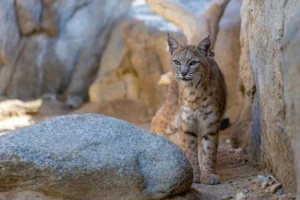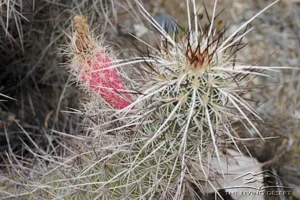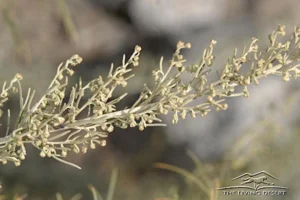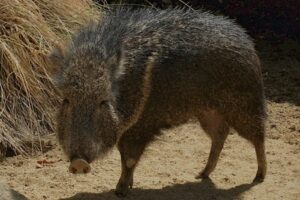Today’s Hours: 8:00am – 5:00pm
Today’s Hours: 8:00am – 5:00pm
Explore Habitats and Encounter Our Majestic Animals.

Species Name:Lynx rufus
Bobcats are on the alert for prey day or night, which includes rabbits, hares, rodents, quail, reptiles and carrion. Adults are preyed on by mountain lions while coyotes and foxes prey…
Read MoreFelidae, the cat family.
Least Concern, IUCN; common
Temperate and subtropical North America.
Most habitats, but prefer rough, rocky country interspersed with dense cover and abundant prey.
Bobcats get their name from their short, stubby tails, and their bobbing gait.
Bobcats are on the alert for prey day or night, which includes rabbits, hares, rodents, quail, reptiles and carrion. Adults are preyed on by mountain lions while coyotes and foxes prey on the young.
Their coats are light brown marked with spots and bars. Their bellies are white with dark markings and their tails are very short and stubby. Males are larger than females. Facial tufts or “sideburns” and ear tufts may aid their keen hearing while black and white ear spots may be used as communication signals.
Males and females come together only for breeding from February to June and, after a gestation period of 60 days, 1-5 kittens are born, which are reared by the mother alone. The kittens leave her at 9-10 months to establish their own territories. Their potential lifespan is 12-14 years in the wild and up to 25 years in captivity.
Bobcat populations vary in size, color, prey type, and home-range size depending on habitat type. They are solitary and, throughout their home ranges, they mark their territories with urine, anal gland secretions, feces or piles of duff or dirt called “scrapes” to warn off other bobcats.
Species Name:Fouquieria columnaris
Dominated by a central pachycaul trunk, older wild specimens of this tree often grow in irregular and whimsical silhouettes.
Read MoreDominated by a central pachycaul trunk, older wild specimens of this tree often grow in irregular and whimsical silhouettes.

Species Name:Echinocereus engelmannii
Read MoreCactaceae, Cactus Family
Sonora and Mojave deserts of southwestern U.S. and northern Baja California
Rocky soil of hillsides, canyons and washes
Succulent to 2 ft. tall by 3 ft. wide
The show stopping flowers form sweet red fruits.

Species Name:Artemisia californica
Read MoreAsteraceae, Sunflower Family
Central and southern California, Baja California
Coastal sage scrub, chaparral, dry foothills
Shrub
Ethnobotanic Garden
It is an important habitat plant for the endangered California Gnatcatcher.
Species Name:Euphorbia ingens
The Candelabra tree is a succulent tree-like euphorbia species native from northern South Africa to Kenya where it inhabits dry areas and grasslands. It grows up to 20 feet tall or…
Read MoreThe Candelabra tree is a succulent tree-like euphorbia species native from northern South Africa to Kenya where it inhabits dry areas and grasslands. It grows up to 20 feet tall or more and produces many branches giving it a candelabra-like structure. Its inconspicuous flowers provide nectar for butterflies and bees and its seeds are eaten by birds. It produces highly toxic milky latex sap that can cause blindness, skin irritation, and poisoning if ingested. Its stems have been used as fish poison, but the candelabra tree also has purported medical uses and its light wood has been used for doors, planks, and boat construction.

Species Name:Hystrix africaeaustralis
They are mostly vegetarians, feeding on wild roots, bulbs, berries and other plants. In cultivated areas they eat groundnuts, potatoes, pumpkins, melons and maize. Lions have been known to prey on…
Read MoreHystricidae, the Old World porcupines.
Least Concern, IUCN.
Sub-saharan Africa excluding the coastal deserts of the southwest
Adaptable – found in forests, on plantations, in rocky or mountainous areas and in deserts.
They cannot shoot their quills.
They are mostly vegetarians, feeding on wild roots, bulbs, berries and other plants. In cultivated areas they eat groundnuts, potatoes, pumpkins, melons and maize. Lions have been known to prey on Cape Porcupine.
Adults grow to 25-29 inches long and weigh from 20-66 pounds. The quills on the neck and back are black and white and the tips of the tail quills can range up to 20 inches long. They make a rattling sound when the porcupine feels threatened. It is sometimes called a crested porcupine because some quills can be erected into a crest, which starts at the top of the head and extends to the shoulder.
Females produce 2 to 3 litters of 1 or 2 young every year, in a grass-lined burrow. Babies are covered with bristles and soft quills which harden a few hours after birth. The mother nurses them from teats located on the sides of her body, away from her quills.
When attacked or annoyed, porcupines raise their quills and rattle them vigorously to scare off predators. They may charge sideways or backward, detaching quills into the flesh of the attacker. Once barbed quills enter the skin, they are almost impossible to remove and the wounds become infected, eventually killing the attacker.

Species Name:Catagonus wagneri
Chacoan peccary is the largest of the peccaries. Males and females look alike. The bristly coat is speckled charcoal or brownish-gray, interspersed with long guard hairs, which may be up to…
Read MoreTayassuidae, peccary family
Endangered, IUCN
Bolivia, Argentina, and Paraguay.
Semi-arid thorn forest areas of low rainfall and high temperature
Until recently, this species was known to science only through fossil remains. The first modern-day sightings of live Chacoan peccaries in Paraguay were reported in 1972.
Chacoan peccary is the largest of the peccaries. Males and females look alike. The bristly coat is speckled charcoal or brownish-gray, interspersed with long guard hairs, which may be up to 8-9” long. There is a whitish collar across the shoulders and under the chin, which is thinner and less distinct than that in the Collared peccary. There is a black dorsal stripe, which trails onto the tail. The head is extremely large, and the nose tapers to a snout disc made of cartilage. The long, donkey-like ears are covered with long, pale hair, as are the legs. The legs are relatively long and adapted for running, with dewclaws only on the forelegs.
Chacoan peccary uses its snout to roll cacti on the ground, rubbing the spines off. Its kidneys are specialized to break down acids from the cacti, and its two-chambered stomach is well suited to digest its food. The bristly brownish-gray coat provides excellent camouflage, and peccaries’ tiny feet help them to pick their way through their thorny habitat. Chacoan peccaries also possess a third hind toe, while other peccaries only have two.

Species Name:Acinonyx jubatus
In just a few strides, a cheetah can run as fast as a car on the freeway. While running, the cheetah’s flat-shaped tail acts like the rudder of a boat, allowing…
Read MoreFelidae, the cat family.
Vulnerable.
Southern Africa, East Africa, parts of the Sahara and Sahel, and Central Iran.
Desert, grassland, savannah, and arid forest.
In just a few strides, a cheetah can run as fast as a car on the freeway. While running, the cheetah’s flat-shaped tail acts like the rudder of a boat, allowing swift turns midair with superior steering and balance.
After catching their prey, cheetahs must recover and eat quickly to avoid other predators that may drive them away from their meal.
Cheetahs are primarily threatened by habitat loss and human-wildlife conflict. The Living Desert actively participates in cheetah conservation in the international Cheetah Public Engagement program for the Saving Species From Extinction Program and a number of international cheetah conservation organizations

Within this garden, native northern Chihuahuan desert plants thrive and showcase their resilience in the arid landscape. Prickly pear cacti, towering yuccas, and majestic sotols adorn the sandy terrain, creating a…
Read MoreWithin this garden, native northern Chihuahuan desert plants thrive and showcase their resilience in the arid landscape. Prickly pear cacti, towering yuccas, and majestic sotols adorn the sandy terrain, creating a picturesque scene that truly captures the essence of North America’s largest hot desert.